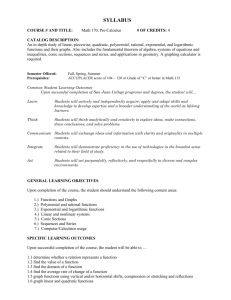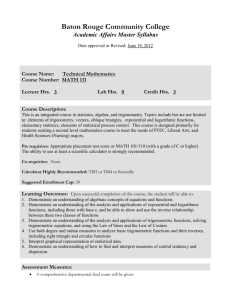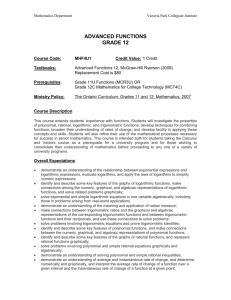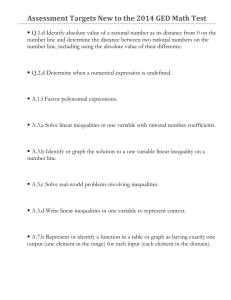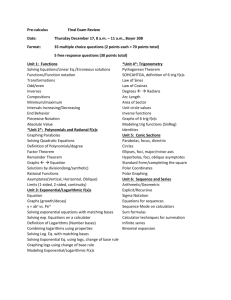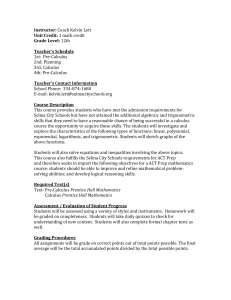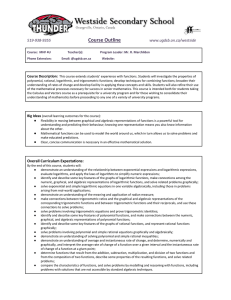AAT H Syllabus Spring 2016 - Palisades School District
advertisement
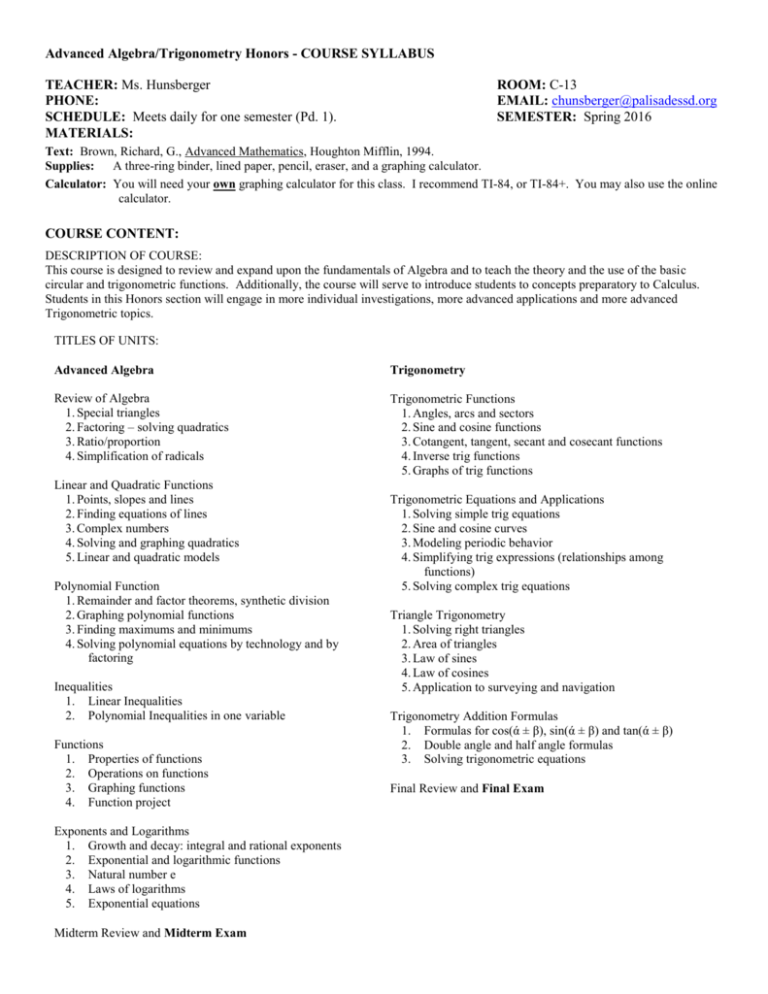
Advanced Algebra/Trigonometry Honors - COURSE SYLLABUS TEACHER: Ms. Hunsberger PHONE: SCHEDULE: Meets daily for one semester (Pd. 1). MATERIALS: ROOM: C-13 EMAIL: chunsberger@palisadessd.org SEMESTER: Spring 2016 Text: Brown, Richard, G., Advanced Mathematics, Houghton Mifflin, 1994. Supplies: A three-ring binder, lined paper, pencil, eraser, and a graphing calculator. Calculator: You will need your own graphing calculator for this class. I recommend TI-84, or TI-84+. You may also use the online calculator. COURSE CONTENT: DESCRIPTION OF COURSE: This course is designed to review and expand upon the fundamentals of Algebra and to teach the theory and the use of the basic circular and trigonometric functions. Additionally, the course will serve to introduce students to concepts preparatory to Calculus. Students in this Honors section will engage in more individual investigations, more advanced applications and more advanced Trigonometric topics. TITLES OF UNITS: Advanced Algebra Review of Algebra 1. Special triangles 2. Factoring – solving quadratics 3. Ratio/proportion 4. Simplification of radicals Linear and Quadratic Functions 1. Points, slopes and lines 2. Finding equations of lines 3. Complex numbers 4. Solving and graphing quadratics 5. Linear and quadratic models Polynomial Function 1. Remainder and factor theorems, synthetic division 2. Graphing polynomial functions 3. Finding maximums and minimums 4. Solving polynomial equations by technology and by factoring Inequalities 1. Linear Inequalities 2. Polynomial Inequalities in one variable Functions 1. Properties of functions 2. Operations on functions 3. Graphing functions 4. Function project Exponents and Logarithms 1. Growth and decay: integral and rational exponents 2. Exponential and logarithmic functions 3. Natural number e 4. Laws of logarithms 5. Exponential equations Midterm Review and Midterm Exam Ch 6 Polynomials and Polynomial Functions 1. Polynomial Functions Trigonometry 2. Polynomials and Linear Factors 3. Dividing Polynomials Trigonometric Functions 4. Angles, Solvingarcs Polynomial Equations 1. and sectors 5. Theorems About Roots 2. Sine and cosine functions 3. Cotangent, tangent, secant and cosecant functions Ch4.7Inverse Radicaltrig Functions functionsand Rational Exponents Supplement - Properties 5.* Graphs of trig functions of Exponents (Pg. 368) 1. Roots and Radicals Expressions (ignore Abs Value Notation) Equations and Applications Trigonometric 2. Solving Multiplying and Dividing Radical Expressions 1. simple trig equations 3. Sine Binomial Radical Expressions 2. and cosine curves 4. Modeling Rational Exponents 3. periodic behavior 5. Simplifying Solving Square Root and Other Radical Equations 4. trig expressions (relationships among functions) Ch5.8Solving Exponential andtrig Logarithmic complex equations Functions 1. Exploring Exponential Models 3. Logarithmic Functions and Inverses Triangle Trigonometry 4. Solving Properties oftriangles Logs 1. right 5. Area Logarithmic & Exponential Equations 2. of triangles 3. Law of sines Ch4.9Law Rational Functions of cosines 4. Application Rational Expressions 5. to surveying and navigation 5. Adding and Subtracting Rational Expressions 6. Solving Rational Trigonometry AdditionEquations Formulas 1. Formulas for cos(ά ± β), sin(ά ± β) and tan(ά ± β) Ch2.4 Matrices (Timeand permitting.) Double angle half angle formulas 1. Introduce Dimensions equations 3. Solving trigonometric 2. Adding & Subtracting Matrices 7. Solving & Show Final ReviewSystems and Final Examhow to calc determinant Probability Unit (Time permitting.) 1-6 Probability 6-7 Permutations/Combinations 9-7 Probability of Multiple Events Final Exam Review and Final Exam EVALUATION: Quarter Grade: Course Grade: Test, Quizzes, and Performance Tasks: 90% Homework/Class work: 10% First Quarter: 40% Second Quarter: 40% Exams (Average of Midterm and/or Cumulative Final): 20% CLASSROOM POLICIES: DO your classwork and homework to really learn the material, not just to get it done!! Show all work! Help yourself and your classmates by fully participating in class and in your groups. Ask questions and explain your understanding of the concepts fully. Carefully check your work! A retest will be given only if you have maintained an A average on your homework in that chapter, you must come in for extra help, and you must retest within 2 weeks of the original test. The highest score you can get on a retest is a 70%. Get help as soon as you start to struggle and be persistent in trying to gain a full understanding of the concepts. Absences, lateness, and plagiarism will be dealt with according to school policy. See your student handbook for details. If you miss class to participate in a school-approved trip or activity, the assignment is still due! (Student Handbook). HOMEWORK/BELL-RINGER POLICY: When you come into class, get your homework out and get started on the bell-ringer for the day. Do your work on a separate sheet of paper and write the answers in the calendar square for that day. As you are doing the bell-ringer, I will come around and check your homework. Homework will be assigned regularly. Late homework will receive no credit. Work must be shown for each problem, answers only is not acceptable! Grades for homework will be determined as follows: Full credit: All problems are completed, corrected and well explained. Half credit: Partially done, with at least half completed or corrected and/or many explanations are missing. No credit: Less than half has been attempted and/or less than half of the explanations are missing. Do it to learn and ask questions if you are unsure. HAVE SOMETHING WRITTEN FOR EVERY PROBLEM! 1 You will sign your name in the homework booklet if you have not done your homework, or sign your name − 2 if it is partially done. Bell Ringer Checks: You will be expected to have an answer for every day there is a bell ringer, and at the end of each month you will hand in a bell ringer check (3 random dates will be chosen). If you are absent, get the answer from a classmate. Homework Checks: You will be expected to hand in work and answers randomly when asked for. PORTFOLIO ENTRIES: Projects and selected performance assessments all make great portfolio entries. **Course content may vary from this outline to meet the needs of this particular student.**


